TEA
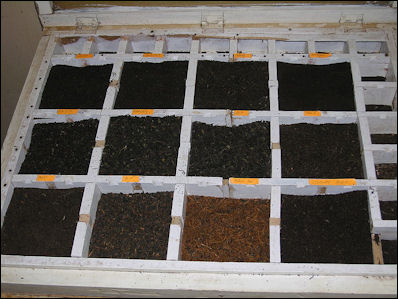
Types of Sri Lankan tea Tea is the most popular drink in the world after water. A lot more people drink it than coffee, especially in China, India, Japan, Britain, Russia, Turkey and other countries in Asia, eastern Europe and the Middle East. Hot or iced, bagged or loose, black or green — whatever form it takes, enjoying a cup of tea is an act performed at least three billion times a day the world over. The United States is one of the places it is not the most popular drink. There tea trails behind soft drinks, beer, milk and coffee in popularity. In contrast to the rest of the world which likes its tea hot, 80 percent of the tea served in the U.S. is cold. However, U.S. tea sales quadruped between the late 1990s and the late 2000s, reaching the $5 billion mark in 2005 and reached $10 billion in the early 2010s.
According to the Fowler Museum at UCLA: Traveling from Asia to the West, tea has played a variety of profound roles on the world scene — as an ancient health remedy, an element of cultural practice, and source of spiritual insight. Historically it was also a catalyst for international conflicts and horrific labor conditions in various countries. “Throughout its history tea has been a prevalent theme in the visual arts — scenes of tea embellish ceramics and textiles and are the subject of paintings and drawings, and all manner of vessels have been fashioned for the preparation and presentation of tea. Art forms inspired by tea and used to serve it include Chinese ceramics and paintings, 18th- and 19th-century Japanese ceramics and prints, English and Colonial American paintings, and tea-serving paraphernalia and furniture from many countries. [Source: “Steeped in History: The Art of Tea” exhibition, Fowler Museum at UCLA, August 16-November 29, 2009]
Tea is a drink made with the leaves of Camelia sinensis, a plant indigenous to southeastern Asia and China. The word “tea” comes from the Xiamen area of China. All the varieties of tea come from Camellia sinensis. Strictly speaking, the term.tea. refers only to the beverage produced with leaves of this plant, whether it is black, green, oolong, yellow, red, or white tea and whether it is loose-leaf, compressed, powdered, or.CTC. (cut-tear-curl). The difference in color and shape is due to the manufacturing process and the varying levels of oxidation to which the tea leaves are exposed — black teas are fully oxidized, oolongs are semi-oxidized, green and white teas are nonoxidized. Chamomile, rooibos, mint, and the like, which are derived from other plants, are herbal infusions, not teas. [Source: Fowler Museum at UCLA]
According to the New York Times: “Tea dips effortlessly into a half-dozen modes — travelogue, biography, nature ode, business story, nerd profile — sustaining a flexibility of tone that allows for both keen insights into the rapidly evolving Chinese economy and drunken raptures on the ability, in one especially prized blend, to taste the mountain.”
TEA CULTIVATION AND PRODUCTION factsanddetails.com ; TEA IN CHINA: HISTORY, BUSINESS AND CONNOISSEURS factsanddetails.com ; KINDS OF CHINESE TEA factsanddetails.com ;TEA DRINKING AND CULTURE IN CHINA factsanddetails.com ;TEA AGRICULTURE IN CHINA factsanddetails.com ; TEA IN JAPAN factsanddetails.com
Websites and Resources: UK Tea Council tea.co.uk ; Tea Production teauction.com ; Tea Production in India scribd.com/do ; Tea Making food-info.net ; Teavana teavana.com ; Wikipedia article on Tea Wikipedia ; Stash Tea stashtea.com Wikipedia article on History of Tea in China Wikipedia ; Rare Teas holymtn.com ; Tea Culture index-china-food.com ; Asia Recipe asiarecipe.com ; 19th Century Tea Trade in China Harvard Business School ; Book: “ All the Tea in China “ by Kit Chow and Ione Kramer;
Tea Plant and Caffeine
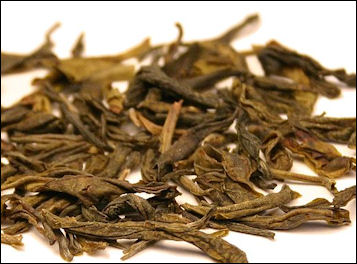
orange pekoe leaves
There are two main varieties of tea plant: the small-leafed China plant and the large-leafed Assam variety, discovered on the Burma-India border in 1824. There is also a Cambodian variety used mostly in hybrids. The Chinese type — Camellia sinensis var. sinensis, — is multiple-stem shrub with small leaves. It is long-lived and can withstand cold weather. The Indian type — Camellia sinensis var. assamica — is a single-stem plant with larger, softer leaves — more like a tree if left unpruned. It is more delicate, shorter-lived, and best grown in subtropical and rainy regions. [Source: Fowler Museum at UCLA]
Tea contains caffeine but significantly less than coffee. A typical cup of tear-bag-brewed tea contains 40 millimeters of caffeine, compared to 100 millimeters for a typical cup of brewed coffee. The caffeine content of tea can range from 20 to 90 milligrams per cup depending on the blend of tea leaves, method of preparation and length of brewing time. Contrary myth, green tea contains about the same amount of caffeine as black teas but caffeine levels can range between 20 and 90
John Foxe, a professor of neuroscience at the City University New York, told U.S. News and World Report, “We have reports going back thousands of years that drinking tea makes people feel relaxed. But it also seems to make them more alert.” Fox has studied the affects of the amino acid theanine — found in all kinds of tea — and found it causes a decrease in the brain’s “alpha rhythms” when people perform complex attention tasks, causing them to pay closer attention. Evidence also indicates that caffeine and theanine work well together, each boosting each other’s effects.
Popularity of Tea Around the World
Tea has a long cultural, culinary and even political history and has spiritual, philosophical, and economic associations. According to the Fowler Museum at UCLA: “In ancient China tea was regarded as one of the seven daily necessities of life; for many Japanese it has served as a ritual element in the quest for enlightenment. For Americans it is often associated with the American Revolution; in the Middle East and North Africa it is a sign of hospitality and poured with dramatic flair; and in England afternoon tea holds an immutable place in the popular imagination. Some like it hot, some like it iced, some with milk, some with lemon. Some want tea black, some green. Some tea drinkers prefer whole leaves, while others use tea brick shavings or tea bags. Whatever form it may take and whatever context it is taken in, enjoying a cup of this ubiquitous beverage is an act performed no less than three billion times a day all around our planet. [Source: “Steeped in History: The Art of Tea” exhibition, Fowler Museum at UCLA, August 16-November 29, 2009]
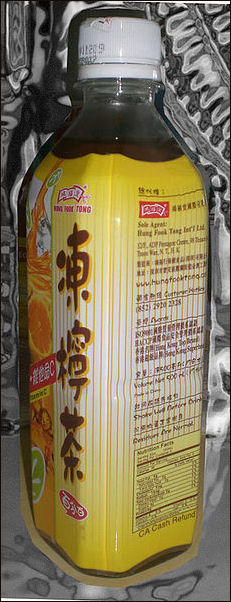
Hung Fook Tong
Lemon Tea
Tea has played a variety of striking roles on the world stage — as an ancient health remedy, an element of cultural practice, a source of profound spiritual insights, but also as a catalyst for brutal international conflict, crushing taxes, and horrific labor conditions. It is thus not surprising that the theme of tea has figured prominently in the visual and literary arts. Scenes of tea embellish ceramics and textiles and are the subject of paintings and drawings, and all manner of vessels have been fashioned for the preparation, presentation, and consumption of tea. Odes are written to its perfection, and social interactions have come to be shaped by the etiquette of tea.
Seeking the origin of the names of favorite teas will give greater understanding of geographic and historic associations of tea. Place names such as Darjeeling, Nilgiri, and Assam name growing regions in India, just as Ceylon (former name of Sri Lanka), and Yunnan (Chinese province) reveal the origin of those teas. Earl Grey, The Prince of Wales, and Caravan teas make obvious historic references. Possibly nothing but speculation will reveal the origin of names as Temple of Heaven, Golden Dreamland, Dragon‘s Well, and Golden Monkey; but more is to be learned about how Gunpowder Tea received its name. Those who drink Lapsang Souchong tea will understand the naming of this tea, originally from China‘s Fujian province where the name means.smoky variety.
Early Tea Use in China
Originating from Southeast Asia and the Yunnan province of China, tea was mentioned in a Chinese dictionary around A.D. 350. Tea processing is believed to date to around A.D. 500. Tao founder Lao-tzu is said to have recommended tea to his followers in the 6th century B.C. Tea was brought to imperial China from Southeast Asia about A.D. 900. It became popular during Tang dynasty, when it was associated with Buddhism (monks reportedly used it to stay awake while meditating). During this period of time, tea was not prepared like it is today. The leaves were first steamed and compressed and then dried and pounded in a mortar. China still produces more varieties of tea than any other nation.
Camellia sinensis was already in use as a medicinal plant in the Zhou dynasty (1046-256 B.C.). The first recorded tea drinkers were the Ba-Shu of China's Sichuan province. By the time the "Chajing", the first book on tea, was written in A.D. 780, tea was widely cultivated in southwestern China and had been elevated to an.elixir of immortality. in Daoism, used as imperial tribute, savored by literati, transported on camelback to the Central Asian steppes and and sold on street corners. The aesthetics of tea culture flourished, evidenced in poetry, paintings of tea scenes, and especially in the Chinese mastery of producing ceramic tea wares. [Source: “Steeped in History: The Art of Tea” exhibition, Fowler Museum at UCLA, August 16-November 29, 2009]
Professor Derk Bodde wrote: “The earliest authentic reference to tea drinking in Chinese literature is one that occurs in the biography of a well-known Chinese historian. It can be dated between the years A.D. 264 and 273. This historian had the misfortune to hold office under an emperor notorious for his drunken sprees. In the early part of this emperor's reign, so the biography tells us, the historian enjoyed the favor of the new ruler. Frequently he was invited to attend drunken feasts at which each guest was expected to drink no less than seven Chinese pints of wine. Our poor historian, alas, suffered bad health, which made it hard for him to keep up with his merry companions on these occasions. His own drinking capacity, the biography adds, was only three pints. [Source: Derk Bodde, Assistant Professor of Chinese, University of Pennsylvania, November 8, 1942, Asia for Educators, Columbia University afe.easia.columbia.edu] Tea is one of the first known stimulants. The legendary Chinese emperor Shen Nung reportedly wrote in his medical diary in 2737 B.C. that tea not only "quenches thirst" but lessens the desire to sleep." According to legend Shen-Nung discovered the drink when some tea leaves from a bush accidently fell into some water he boiling to stay healthy. He liked the taste and tea was born.According to another legend tea was created by an Indian monk with bushy eyebrows named Bodhidharma, who mediated for nine years by staring at the wall of a cave. To battle his occasional bouts of drowsiness, he came up with a novel idea — cutting off his eyelids so his eyes wouldn't close. On the place where he placed his severed eyelids, the first tea bushes appeared.
World’s Oldest Tea — 2,150 Years Old — Found in Xian Emperor’s Tomb
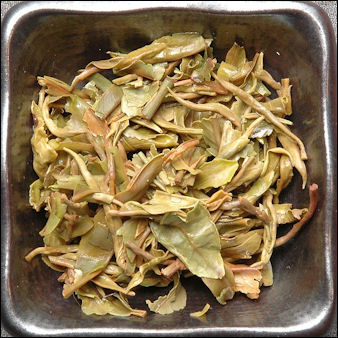
Darjeeling first-flush tea after steeping In January 2016, archaeologists announced they had discovered the oldest tea in the world (2,150 years old) among the treasures buried with a Chinese emperor in Xian and in a tomb in Tibet. Archaeology magazine reported: The finds contain traces of caffeine and theanine — substances particularly characteristic of tea. The tombs are more than 2,000 years old, indicating the beverage was consumed during the Han Dynasty (206 B.C.–A.D. 220). A Chinese document from 59 B.C. that mentions a drink that might be tea was previously the earliest known record of the beverage. Tea does not grow near the tombs, so the discovery indicates that the Silk Road was a “much more complicated and complex long-distance trade network than was known from written sources,” says researcher Dorian Fuller, an archaeobotany professor at University College London. Tea-producing regions, including remote areas of China and even Myanmar, he adds, had “well established supply lines” feeding into the Silk Road. [Source: Lara Farrar, Archaeology magazine, May-June 2016]
David Keys wrote in The Independent, “New scientific evidence suggests that ancient Chinese liked tea so much that they insisted on being buried with it – so they could enjoy a cup of char in the next world. The new discovery was made by researchers from the Chinese Academy of Sciences and published in Nature’s online open access journal Scientific Reports. “Previously, no tea of that antiquity had ever been found – although a single ancient Chinese text from a hundred years later claimed that China was by then exporting tea leaves to Tibet. By examining tiny crystals trapped between hairs on the surface of the leaves and by using mass spectrometry, they were able to work out that the leaves, buried with a mid second century B.C. Chinese emperor, were actually tea. The scientific analysis of the food and other offerings in the Emperor’s tomb complex have also revealed that, as well as tea, he was determined to take millet, rice and chenopod with him to the next life. [Source: David Keys, The Independent, January 10, 2016 -]
“The tea aficionado ruler – the Han Dynasty Emperor Jing Di – died in 141 B.C., so the tea dates from around that year. Buried in a wooden box, it was among a huge number of items interred in a series of pits around the Emperor’s tomb complex for his use in the next world. Other items included weapons, pottery figurines, an ‘army’ of ceramic animals and several real full size chariots complete with their horses. -
See Separate Article FOOD, DRINKS AND CANNABIS IN ANCIENT CHINA factsanddetails.com
Spread of Tea Outside of China
The consumption of tea spread from China to Japan and India between around A.D. 1000 or 1100, perhaps by Buddhist monks. It was originally brought over as a medicine not drink. It did not become popular in Japan with the aristocracy until the 17th century and did not really catch on with ordinary people until the 18th century. In 1609 tea reached Europe via Amsterdam. The French began drinking tea in 1636. In the time of Maria Antoinette the French liked to drink it with macaroons of madeleines but never with milk. The first tea arrived in Britain came from China in 1652. The British established the tea industries in India and Sri Lanka. Iced teas was invented in 1904 by an Englishman in St. Louis. He tried to introduced hot tea to the United States and had little success. Out of desperation he poured over ice. The drink was an immediate success. The same year he came up with he novel of idea of selling tea in bags that could be dropped in the water.
Professor Derk Bodde wrote: ““Several centuries passed before tea became really popular in China. Gradually its use spread to such neighboring countries as Tibet, Mongolia, Korea, and Japan. Only much later did it spread in any great quantity farther afield. In the seventeenth century, travelers who had been in China brought it back with them on their return to Western Europe. They and their tea traveled from China over the southern sea route by way of India. Pepys, in his famous diary, wrote in London on September 25, 1666: "I did send for a cup of tee, a China drink of which I never had drunk before." Within the next century the demand for it had become universal in England. Tea was becoming an important item in world trade. [Source: Derk Bodde, Assistant Professor of Chinese, University of Pennsylvania, November 8, 1942, Asia for Educators, Columbia University afe.easia.columbia.edu]
“Meanwhile, the Russians early in the seventeenth century were also becoming acquainted with tea. They received it, however, by way of the overland route through Central Asia. In course of time they became even greater tea drinkers than the English. The different names for tea in various European languages are an interesting reflection of the two routes taken by it in its travels to the West. Thus the English word tea and the French thé are both derived from the Chinese té. This is the name for tea in the dialect of the southern coastal province of Fujian, from which ships started westward on the southern sea route. The Russian word, chai, on the other hand, is derived from ch'a, which is the way the word for tea is pronounced in North China, where the land route through Central Asia started. Other similar words, also derived from ch'a, are used by the Mongols, Turks, Persians, and modern Greeks.
“From England tea was brought to this country. Its connection with the American Revolution in the form of the "Boston Tea Party" is known to us all. In the first half of the nineteenth century it was the most important single item brought back from Canton around Cape Horn by the Yankee sea captains in their famous clipper ships. In the latter part of the nineteenth century, however, tea growing became a major industry in India, Ceylon, the East Indies, and other regions, and the trade with China declined. Yet even today the most delicate varieties of tea (and there are dozens of them) still come from China.”
Tea Catches on in the West
Francis Ross Carpenter wrote in “The Classic of Tea — Origins and Rituals” (1974): “Tea may be the oldest, as it is surely the most constantly congenial, reminder of the West’s debt to the East.” According to the Fowler Museum at UCLA: Until tea was introduced in Europe in the early seventeenth century, Europeans had not the faintest notion of liquid jade, as tea was called in China. Initially, tea was used most often as a remedy. Tea‘s popularity in Europe began in the early seventeenth century when Dutch traders brought the first commercial shipment of tea from China. Although it took four years for the cargo ships to sail to China and back, the tea was worth waiting for and its use increased, particularly among members of the upper class. To supplement the imported Chinese and Japanese tea utensils used, European artists and manufacturers provided newly designed dishes, teapots and furniture for preparing, serving, and enjoying tea. [Source: “Steeped in History: The Art of Tea” exhibition,Fowler Museum at UCLA, August 16-November 29, 2009]
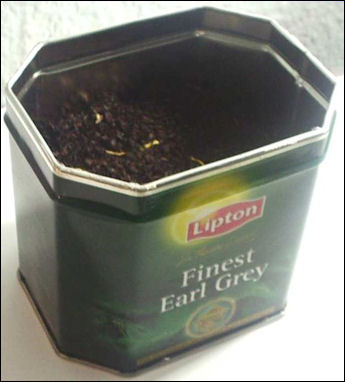
Lipton Earl Grey tin
At about the same tea arrived in Europe, exploration and increased trade with other previously inaccessible parts of the world introduced two other beverages to seventeenth century Europe. Coffee from Arabia and chocolate from Central America joined tea in changing the drinking habits of the people. No longer were beer and ale the most popular drinks. Coffeehouses and tea gardens became the places to meet. In some areas afternoon tea was a daily ritual with proper tea etiquette observed.
The upper classes fully embraced the three exotic caffeinated beverages — coffee, tea, and chocolate — which arrived in Europe more or less at the same time. Gradually these imports became more affordable and their consumption spread to the general population. In England this was due in part to the opening of a new type of establishment, the coffeehouse, which, although initially restricted to men, was a place where people of all walks of life could congregate and talk over a cup of tea. As the regimen of tea was perfected, artists and marketers strove to create the perfect tea accoutrements, and these sometimes became status symbols. Furniture was especially designed for afternoon tea, and the European porcelain industry took off after the long-held Chinese secret of porcelain making was finally understood in Germany in 1708.
Gradually tea, coffee and chocolate became more affordable and their consumption spread to the general population. As the regimen of tea was popularized and perfected, artists and marketers strove to create the perfect tea accoutrements, and these became status symbols. Furniture was especially designed for afternoon tea, like the elegant French tripod table featuring a tea-drinking scene, circa 1680, on display. The European porcelain industry took off after the long-held Chinese secret of porcelain making was finally understood in Germany in 1708. The first tea to reach America was introduced by the Dutch, and the habit of tea drinking spread quickly among the colonies. In order to control the profits of the tea trade, the English Parliament sought to eliminate foreign competition by passing legislation that required colonists to import their tea solely from Great Britain, which led to the colonists buying smuggled tea — at half the price of British tea. This — accompanied by a number of tax acts that collected revenues for the Crown and at the same time penalized colonists’ consumption of smuggled tea — led to tea becoming forever associated with revolutionary actions, of which the Boston Tea Party is only the best known.
In eighteenth- and nineteenth- century England, tea replaced ale as the preferred breakfast drink and was consumed in the afternoon along with scones and other accompaniments at what we think of as high tea, while what was really high tea was the late afternoon light meal served to the family — with tea. In later years the terms afternoon tea, low tea and.high tea became, to some, interchangeable. Low tea, though it sounds less proper, began with the elite, the so-called higher classes. It was the fancier of the teatimes, served in the early afternoon with tea accompanied by snacks or light food. High tea, on the other hand began with the so-called lower or working classes. Served later in the day, it really was the main meal and consisted of meats, fish or eggs, bread, butter, cheese, pickles, and cake, and was also called.meat tea.. No matter the hour, though, tea was served,
As Europeans settled in the Americas they brought with them their preferences, and British colonials even drank more tea here than in England. Colonists met in coffeehouses patterned after familiar ones they‘d left behind and there they discussed the latest news and exchanged ideas. They also served tea at home, using silver and ceramic vessels they‘d brought with them from England and the continent. By the early eighteenth century American silversmiths were producing teapots, sugar bowls, creamers, and hot-water urns. Wanting to control the very profitable trade in tea, England‘s parliament passed laws mandating that colonists buy all their tea from Great Britain and as a means of raising revenue, they imposed taxes on tea and other goods The colonists, often informed by printed broadsides, responded by smuggling in tea from elsewhere, drinking herbal infusions instead of tea, refusing to use imported English goods, and staging numerous and varied demonstrations in protest. The Boston Tea Party is the most widely documented, but just one of many similar protests that took place in colonial America
Tea and the British Empire
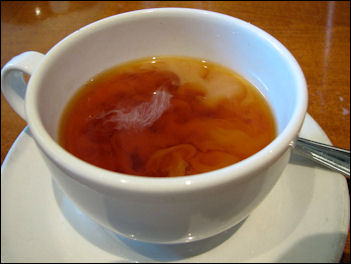
orange pekoe tea with milkAccording to the Fowler Museum at UCLA: Britain‘s ever-increasing appetite for tea brought enormous profit to the British Crown and to the East India Company, but toward the end of the eighteenth century, circumstances began to change. The refusal of China, the sole supplier of tea, to accept anything other than cash payment (preferably silver bullion) had engendered a serious trade imbalance; meanwhile, the East India Company had accrued increasing debt in the course of expanding its control of India beginning in 1757. By the 1830s, the British had responded to these events in two ways: first by actively engaging in the opium trade to China, and second, by developing tea plantations in northern India. Britain‘s opium sales to China guaranteed the cash that the British could then use to purchase Chinese tea. One addiction supported another.[Source: “Steeped in History: The Art of Tea” exhibition, Fowler Museum at UCLA, August 16-November 29, 2009]
Although the tea plant was indigenous to parts of India, this region had not previously produced tea for export. While the opium wars were raging in China, British merchants started growing tea in Darjeeling in northern India. (Tea already had a long history of growth here, but only for local consumption and not for export.) Within less than a hundred years Indian tea had taken over the world market, while Chinese tea was virtually forgotten in England. However, the human price for achieving in a century what had taken China thousands of years to accomplish was incalculable. See British Colonialism, Indentured Servants and Tea Below
In Victorian England, tea drinking flowed from the aristocracy to the working classes. Fancy dress and luxury tea wares set the standard for high society. In India, where the tea was grown, it was served to British colonialists by teams of servants. During the first half of the twentieth century, British colonial interests brought tea cultivation to other areas, especially Sri Lanka and East Africa, making its production a truly global enterprise.
During the 19th century many advances in shipbuilding were made to enable faster delivery of tea. In 1869, a famous clipper ship, the Cutty Sark was launched to transport tea from Asia. She was magnificent with very high masts so that her thirty-four sails caught high winds, moving the ship much faster than ships with older traditional sails. Though clipper ships were expensive to build, one or two successful.tea-runs. from China to England took care of the expense. Tea clipper races became a tradition between the two continents with cash prizes for the victor, the captain of the ship who made the fastest delivery of the perishable cargo. Sailing ships declined in use with the opening of the Suez Canal, and advances in the building of ships that ran on steam. The steamship took over the transport of tea.
Tea and Literature
Tea drinking episodes occur in works by Jane Austen, Charles Dickens, C. S. Lewis, J. R. R. Tolkien, A. A. Milne. Beatrix Potter, Robert Lewis Stevenson, Oscar Wilde, and others. In Lewis Carroll’s “Alice's Adventures in Wonderland”, the Mad Hatter hosts a famous tea party that includes croquet and riddles and wonderful hats.

hong kong Iced milk teaA famous limerick goes: There was an old man who forgot,
That his tea was excessively hot;
When they said ‗Let it cool‘ —
He answered ‗You fool!
I shall pour it back into the pot.”
[Source: Edward Lear, English artist, writer (1812-1888)
The Nobel Laureate for Literature in 1971, Pablo Neruda (1904-1973) from Chile, included “Ode to a Box of Tea” in his collection, “Odes to Common Things” (1994). George Harrison (1943-2001) wrote in The Beatles “It‘s All Too Much”:
Sail me on a silver sun
Where I know that I'm free
Show me that I'm everywhere
And get me home for tea.
Samuel Johnson (1709-1784) wrote:
So hear it then, my Rennie dear,
Nor hear it with a frown;
You cannot make the tea so fast
As I can gulp it down.
I therefore pray thee, Rennie dear,
That thou wilt give to me
With cream and sugar softened well,
Another dish of tea
Vietnamese Zen Buddhist monk and philosopher, Thich Nhat Hanh (b.1926) wrote:
You must be completely awake in the present to enjoy the tea.
Only in the awareness of the present,
can your hands feel the pleasant warmth of the cup.
Only in the present, can you savor the aroma,
taste the sweetness,
appreciate the delicacy.
If you are ruminating about the past,
or worrying about the future,
you will completely miss the experience of enjoying the cup of tea.
You will look down at the cup,
and the tea will be gone.
Life is like that.
If you are not fully present,
you will look around and it will be gone.
You will have missed the feel,
the aroma, the delicacy and beauty of life.
It will seem to be speeding past you.
The past is finished. Learn from it and let it go.
The future is not even here yet.
Plan for it,
but do not waste your time worrying about it.
Worrying is worthless.
When you stop ruminating about what has already happened,
when you stop worrying about what might never happen,
then you will be in the present moment.
Then you will begin to experience joy in life.
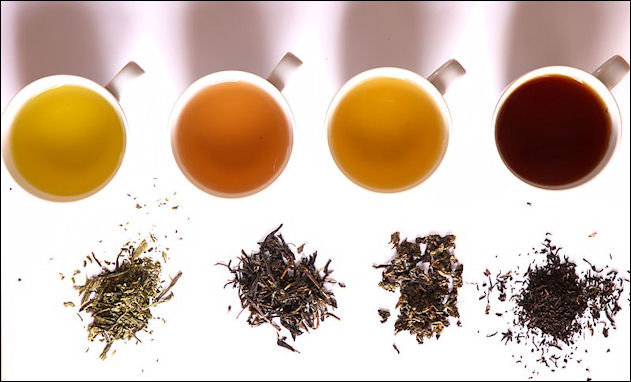
Tea in different grades of fermentation
British Colonialism, Indentured Servants and Tea
Tea was introduced into Britain by Catherine de Braganza, the Portuguese wife of Charles II, in 1673 and popularized by her friend the Duchess of Lauderdale at Ham House in South West London. The tea they drank was green tea. For the next 200 years, nearly all the tea consumed in the UK was Green Tea.
The British established large plantations overseeing the labor of indentured workers, including women and children, who even needed permission, not readily granted, to leave the plantation. The poorly paid workers suffered miserable health and housing conditions; children and women labored long hours. The new plantations prospered for the British, and in 1838 the first shipment of tea grown on British plantations arrived in London from India. Again, to serve British interests, other colonized areas were successfully planted and tea was subsequently grown in Ceylon (now called Sri Lanka) and East Africa in what is now known as Tanzania, Uganda, and most importantly, still today, Kenya. Under the British system of indentured labor employed on the new tea plantations, the lives of Indian workers were scarcely better than those of enslaved Africans. By 1920 more than one million Indian laborers were producing tea for export, and Chinese tea had virtually disappeared from the world market [Source: Fowler Museum at UCLA].
The Indian tea plantations utilized the indenture system to gather laborers from overpopulated rural areas of India. The British Government of India had established the use of penal contracts. to bind these indentured laborers to their plantations. Such contracts gave plantation owners the right to fine, imprison, punish, and forfeit the wages of those who failed to perform their duties or attempted to leave the plantation. The mortality rate on tea plantations was very high, due to malnourishment and exposure to airborne and waterborne diseases. Physical and sexual abuse were rampant, and the danger of wild animals or poisonous snakes was a constant worry for the tea coolie. In short, the system was perhaps worse than slavery, which Britain had abolished in 1833.
The indenture system was not unique to India; it was also employed on British plantations in Mauritius, Fiji, the West Indies, Southeast Asia, and East Africa. By 1914 the Empire was comprised of eighty territorial units, eleven million square miles, and four hundred million colonial subjects. The ability of some Londoners to live in luxury was enabled by the creation of an interconnected imperial world in which the freedom to consume at home depended on the domination of others abroad.
Today, India is one of the largest tea producers in the world, though over 70 percent of the tea is consumed within India itself England continued to manage the tea estates until India gained its independence in 1947. New laws gave more hope for the future to children of the workers, but the workers themselves continued to receive low wages for long hours of difficult work, even under Indian management. A social movement called. Fair Trade. developed as a response. The movement‘s many goals serve to support sustainability, education, fair pricing and wages, safe working conditions, and healthcare programs. Other provisions ban child and slave labor and promote the protection and conservation of the environment.
"A Nice Cup of Tea" by George Orwell
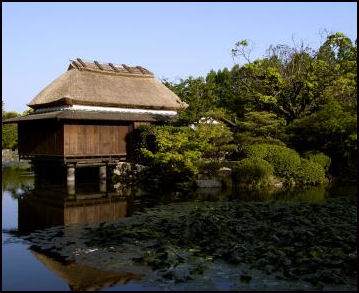
Japanese tea house
In his essay "A Nice Cup of Tea", British author George Orwell wrote: When I look through my own recipe for the perfect cup of tea, I find no fewer than 11 outstanding points. On perhaps two of them there would be pretty general agreement, but at least four others are acutely controversial. Here are my own 11 rules, every one of which I regard as golden: 1) First of all, one should use Indian or Ceylonese tea. China tea has virtues which are not to be despised nowadays—it is economical, and one can drink it without milk—but there is not much stimulation in it. One does not feel wiser, braver or more optimistic after drinking it. Anyone who has used that comforting phrase ‘a nice cup of tea’ invariably means Indian tea.
2) Secondly, tea should be made in small quantities—that is, in a teapot. Tea out of an urn is always tasteless, while army tea, made in a cauldron, tastes of grease and whitewash. The teapot should be made of china or earthenware. Silver or Britanniaware teapots produce inferior tea and enamel pots are worse; though curiously enough a pewter teapot (a rarity nowadays) is not so bad. [Source: George Orwell, Evening Standard, January 12, 1946]
"3) Thirdly, the pot should be warmed beforehand. This is better done by placing it on the hob than by the usual method of swilling it out with hot water. 4) Fourthly, the tea should be strong. For a pot holding a quart, if you are going to fill it nearly to the brim, six heaped teaspoons would be about right. In a time of rationing, this is not an idea that can be realized on every day of the week, but I maintain that one strong cup of tea is better than twenty weak ones. All true tea lovers not only like their tea strong, but like it a little stronger with each year that passes—a fact which is recognized in the extra ration issued to old-age pensioners. 5) Fifthly, the tea should be put straight into the pot. No strainers, muslin bags or other devices to imprison the tea. In some countries teapots are fitted with little dangling baskets under the spout to catch the stray leaves, which are supposed to be harmful. Actually one can swallow tea-leaves in considerable quantities without ill effect, and if the tea is not loose in the pot it never infuses properly.
"6) Sixthly, one should take the teapot to the kettle and not the other way about. The water should be actually boiling at the moment of impact, which means that one should keep it on the flame while one pours. Some people add that one should only use water that has been freshly brought to the boil, but I have never noticed that it makes any difference. 7) Seventhly, after making the tea, one should stir it, or better, give the pot a good shake, afterwards allowing the leaves to settle. 8) Eighthly, one should drink out of a good breakfast cup—that is, the cylindrical type of cup, not the flat, shallow type. The breakfast cup holds more, and with the other kind one’s tea is always half cold—before one has well started on it. 9) Ninthly, one should pour the cream off the milk before using it for tea. Milk that is too creamy always gives tea a sickly taste.
"10) Tenthly, one should pour tea into the cup first. This is one of the most controversial points of all; indeed in every family in Britain there are probably two schools of thought on the subject. The milk-first school can bring forward some fairly strong arguments, but I maintain that my own argument is unanswerable. This is that, by putting the tea in first and stirring as one pours, one can exactly regulate the amount of milk whereas one is liable to put in too much milk if one does it the other way round. 11) Lastly, tea—unless one is drinking it in the Russian style—should be drunk without sugar. I know very well that I am in a minority here. But still, how can you call yourself a true tea-lover if you destroy the flavour of your tea by putting sugar in it? It would be equally reasonable to put in pepper or salt. Tea is meant to be bitter, just as beer is meant to be bitter. If you sweeten it, you are no longer tasting the tea, you are merely tasting the sugar; you could make a very similar drink by dissolving sugar in plain hot water.
"Some people would answer that they don’t like tea in itself, that they only drink it in order to be warmed and stimulated, and they need sugar to take the taste away. To those misguided people I would say: Try drinking tea without sugar for, say, a fortnight and it is very unlikely that you will ever want to ruin your tea by sweetening it again. These are not the only controversial points to arise in connection with tea drinking, but they are sufficient to show how subtilized the whole business has become. There is also the mysterious social etiquette surrounding the teapot (why is it considered vulgar to drink out of your saucer, for instance?) and much might be written about the subsidiary uses of tealeaves, such as telling fortunes, predicting the arrival of visitors, feeding rabbits, healing burns and sweeping the carpet. It is worth paying attention to such details as warming the pot and using water that is really boiling, so as to make quite sure of wringing out of one’s ration the 20 good, strong cups that two ounces, properly handled, ought to represent."
Forms of Tea
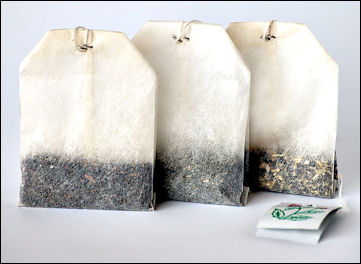
Since early times tea has been processed into several forms: brick, powder, and the more recognizable to us, leaves. More recent and very popular forms of tea are tea bags, iced tea, bubble tea, and the one that is not really a tea at all: herbal teas. Bubble tea, popular mainly in Southeast Asia and the United States, is a combination of milk, tea, sugar and crushed ice poured over balls of tapioca). [Source: “Steeped in History: The Art of Tea” exhibition, Fowler Museum at UCLA, August 16-November 29, 2009]
Brick: Tea It was easier to travel with the compressed tea in brick form than in containers of loose leaf tea, and the bricks stood up better under difficult travel conditions. (To make the beverage, people in Central Asia and the Himalayan regions would — and continue to — break or shave off a piece of the brick or cake and boil it.) A testament to its value: tea bricks were used as currency, scoring along the back aided in the breaking off of smaller pieces that served as change. Today compressed tea is mainly produced for ornamental use, formed into a variety of shapes and sold as souvenirs, often with a decorative shape pressed into the brick.
Powdered Tea: Tea leaves were easily ground into a fine powder and whipped with hot water in individual bowls. Over the centuries its popularity waned in China, but continued in importance in Japan, including its use in the Japanese tea ceremony. Finely powdered green tea, known as matcha, is today used to flavor many foods such as cakes, candy and green tea ice cream. In the United States it is popular in drinks — lattes, energy drinks, smoothies — served in coffee and tea houses, and in juice bars.
Tea Bags are convenient but they produce a low quality cup of teas, says connoisseurs, because they contain inferior pekoe dust not flavorful whole leaves. The thickness of the bag means the tea leaves must be ground until they are practically dust. When wet the bag collapses on itself, preventing water from properly circulating through the leaves. About 96 percent of the tea consumed worldwide is made using tea bags, an American invention developed more than a century ago. In Britain, more than 135 million bags are used every day.
Herbal Teas and Tea Additives can grouped by 1) their families (i.e., chamomile, rooibos, ginger, mint, etc.); 2) the parts of the plants that are used — leaves (mintand hydrangea, bark (cinnamon), flowers (chrysanthemum, chamomile, lime blossom), fruit peels (bergamot orange, lemon), roots (ginseng, licorice, ginger), seeds (fennel, coriander, cardamom and , berries (goji). [Source: Fowler Museum at UCLA]
Kinds of Tea
True teas (excluding so called "teas" for their plants) are divided into four categories according to methods of processing: 1) unfermented, 2) slightly fermented, 3) semi-fermented; and 4) fermented. The reference to fermentation is misleading because tea undergoes oxidation not fermentation.
There are thousands of different kinds of tea. Different soils, different climates, different altitude, different drying methods can all affect the flavor and look of a tea. Many companies blend teas and produce teas that favorable to people in certain regions.
Teas are also categorized by size, quality and the elevation they are grown. Tea particle sizes range from “dust,” to fannings and broken grades to “leaf” tea. Quality is described with words like flowery and pekoe (Orange Pekoe is a quality name as has nothing to with the color of the tea or oranges).
Low-grown teas (those grown under 600 meters) are full bodied but lacking flavor. High-grown teas (those grown above 1,200 600 meters) grow more slowly and are known their subtle flavoring. flavor. Mid-grown teas are between the two. Most commercials teas are blends with some high-grown leaves for flavor and low-grown leaves for body.
According to the Fowler Museum at UCLA: Black tea, by far the most popular in the United States, goes through the most complete processing including fermentation Green tea leaves are not fermented or withered, but, after the leaves are harvested, they are put into a steamer and heated. They are then dried, but no oxidation takes place and the leaves remain green. This tea, increasingly popular in the United States is still mainly drunk in Eastern Asia. The tea is light in both color and taste. Oolong is semi-fermented, therefore the leaves are a greenish-brown color. We mostly encounter it in Chinese restaurants and as part of a multi-blended tea. White tea, is uncured and unoxidized or only slightly oxidized. Only top buds and young leaves, not fully opened, are used. It is scarcer than the other teas and therefore more expensive. [Source: Fowler Museum at UCLA]
Dark green or black oolong teas are 30 to 70 percent oxidized. Most common in China, they are exposed to heat and light and crushed for less time than black tea. Their level of processing is about half way between green and black tea. They have strong and sometime flowery fragrance and fruity, mellow flavor. Common mainland oolong teas include Tikuanyin, shuxian and dahongpao. Taiwan oolong tends to be milder than mainland teas with an emphasis on fragrance over flavor
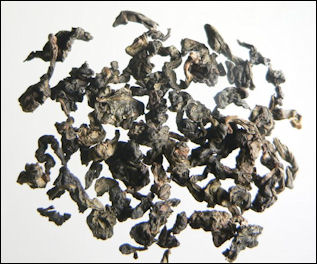
oolong tea Oolong teas are infused with nearly boiling water in very small round-bottomed pots that almost fill to the top with leaves that expand in the water. Tea connoisseur Ip Wingichi told the New York Times, "Oolong is bitter and sweet, with good memories, sometimes quite uncomfortable. But only when you have seen the vicissitudes of life will you understand the meaning of it."
Scented teas, such as jasmine tea, and compressed teas in cake form are made both from oolong and red teas. Herbal teas are made from a variety of plants. They are not true teas because they are not are made with the tea plant. Red tea sometimes refers to herbal teas made from the South African rooibos shrub. It has a strong taste and smells earthy. It is high in antioxidants and is caffeine free.
Non-drink products made from tea include Green Tea Cooling Bubbles Foot Lotion and Green Tea Radiant Body Foam made by Elizabeth Arden.. A French fragrance company has introduced a tea-scented perfume spray made with Chinese Lapsang Souchong, Indian Darjeeling and Sri Lankan Orange Pekoe. Super-model Claudia Schiffer, actress Michelle Pfeifer and actress Isabelle Adjani are among those who are said to use it.
Green Tea and Black Tea
Green teas are the least processed of all teas. They are steamed, rolled and dried (in Japan) or pan fried (in China) soon after picking to kill the enzymes and prevent oxidation before drying. Green tea has a slightly bitter, grassy flavor. The fragrance at first is grassy but later becomes sweet. The taste has been described as "fresh, energetic and sweet."
Green teas are popular in Japan, China Pakistan and Afghanistan. Since of discovery of possible health benefits they has become more popular in the West. The most prized green tea — longjin — is produced mainly in the Hangzhou area of east Chin and is drunk in April and May less than a month after the Ching Ming tea harvest festival.
When making green tea, the water should ideally be cooled to 158̊F to 176̊F (boiling is 212̊F) and made in a broad-bottomed pot preferably made of stoneware that allows heat to escape and exposes the maximum amount of tea-leaf surface to the water. Longjin and other green teas are made in lidded white cup called a chung from which the tea is poured into smaller cups.
Black teas (or red teas) are highly processed and oxidized. After picking the leaves are exposed to air, then crushed and stored in a temperature- and moisture-controlled room, where they oxidize, or ferment, which turns the leaves deep brown and intensifies their flavor. Grown primarily in India and Sri Lanka, these are teas most familiar to Westerners and are the mostly widely consumed in Europe, North America, Russia and the Middle East Black teas are made in a slightly larger pot with fully boiling water.
In recent years green tea has become increasingly popular in the United States and Europe. Many who drink it in the United States do so for its purported health benefits. As of 2002, it accounted for 8 to 9 percent of total U.S. tea consumption. Some Starbucks sell Matcha Cream Frappuccino. Green tea has been popular before. From the 1870s to World War II, 90 percent of the tea imported into the United States was Japanese green tea. Minerals were added to the tea that gave it a brownish color like black tea.
Tea and Health
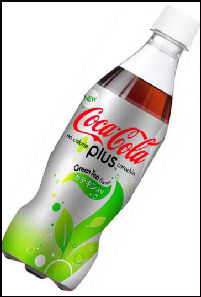
green tea Coke Tea contains a number antioxidants, chemicals that prevent cell damage caused highly reactive molecules called free radicals that are often associated with cancer and to a lesser extent heart disease. Polyphenols are a kind of antioxidant found in tea that have been shown to deactivate substances that help cancer grow and block the action of enzymes that cancers need for growth. Polyphenols are also found in red wine. Polyphenols in tea, particularly green tea, are more potent than polyphenols from other sources such as Vitamins C and E. Black tea has more complex antioxidants than green tea, and these appears to benefit the heart.
Tea contains large amounts of catechins — a type of tannin — with antioxidant qualities linked with longevity, reducing blood pressure, and preventing cancer, heart and liver diseases. Tannins are organic substance found in tea and wood. Taken in large amounts tannins tannin can be toxic but their negative affects in the human body can be reduced if consumed with milk.
A study by scientist sat Brigham and Women’s Hospital in Boston found that the immune system of people who drank five to six cups of Lipton tea every day for two to four weeks produced five times more infection-fighting interferon cells than people who drank a similar amount of coffee. The interferon cells were produced by gamma delta T cells in the immune system triggered by amino acids called L-theanine found in large quantities in tea.
J. Jonker of Amsterdam wrote in 1670:
Tea that helps our head and heart.
Tea medicates most every part.
Tea rejuvenates the very old.
Tea warms the hands of those who're cold.
William Gladstone (1809-1898) wrote:
If you are cold, tea will warm you;
if you are too heated, it will cool you;
if you are depressed, it will cheer you;
if you are exhausted, it will calm you.
Green Tea and Health
Green tea more vitamins, particularly B1 B2 and C, than other teas because it is not processed. Green Tea is high in antioxidants and relatively low in caffeine. The relatively light processing, used to make Green Teas, causes them to have particularly high levels of catechin polyphenols — the most important of which is epigallocatechin gallate (EGCG), a powerful antioxidant which has been linked to inhibiting cancer and heart disease.
Strongly associated with cancer fighting, EGCG has 30 times more radical-fighting effect that vitamin E and 500 times more than vitamin C. EGCG can prevent the growth of blood vessels, which supply nutrients to cancerous tumors that they need to grow. It was once thought that green tea contains significantly more polyphenols such as EGCG than other teas but the amounts are more or less the same.
There is evidence that green tea prevents second heart attacks among people who have already had one; reduces muscle degeneration; cuts the infecting-ability of viruses and bacteria; and offers bacteria to protection from prostrate, breast, stomach and colon cancer. A study in Italy showed that men of high risk of getting prostate cancer who took the equivalent of three or four cups of green tea a day were less likely to develop cancer than similar men given a placebo.
Studies of Tea and Health
Most of the evidence on tea's health benefits come animals studies. These include studies that show mice given polyphenols are less likely to develop arthritis and that tea inhibits the growth of tumor. Animals have show that polyphenols combat cancer, and are particularly effective in combating cancer of the oral cavity and digestive tract.
A number of studies have addressed the cancer-fighting qualities of tea. A study in China showed that polyphenols reduced the size of pre-cancerous mouth lesions. A study in the United States with 35,000 women, showed that tea consumption reduced the chances of developing cancer in the digestive and urinary tract. A study with 110,000 men and women in the Netherlands indicated that tea drinking reduced cancers of the lung, breast and colon.
A number of studies have addressed the benefits tea to the heart. A study in China showed that heavy tea drinking lowered cholesterol levels. A study in Japan has linked oolong tea with lowering cholesterol levels. A Harvard study in the United States indicated that black tea drinkers were half as likely to get heart disease as non tea drinkers. The popularity of tea in Japan and China may partly explain why rates of heart diseases are so low there.
Tea drinking has also been linked with reducing cavities and fighting plaque. One study has shown that it kills cavity-causing bacteria. Another study found that tea drinkers have a better chance of surviving a heart attack than non tea-drinkers.
The jury is still out as to whether tea and green tea are the elixirs that they have has been touted to be. Positive results from animals studies don’t necessarily translate to positive results for humans. Human studies have been inclusive. In studies that have showed reduced cancer, disease or cholesterol levels among green tea or tea drinkers, it is difficult to prove that the tea lead to the positive result not something else. Many tea drinkers also eats lots of fruits and vegetables and it is difficult to ascertain which things are actually providing the help.
Tea Drinking
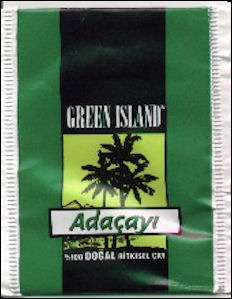
Turkish teabag Infusion — soaking the leaves — is the best way to make tea. Water and a good pot are important for making the best tea possible. Teas should be infused for about a minute, not "stewed." Stewed tea or tea made with water that is too hot produces an unpleasant bitter taste. One batch of tea usually provides between three and five infusions.
The freshness and chemical make up of the water used in making the tea is also important. Tap water should be avoided. Spring water with a low mineral content is best although some mineral waters enhance the sweetness of green teas. To make a proper pot of tea, the tea first should be allowed to reach room temperature before opening to keep condensation off the leaves.
Tea leaves absorb smells, and exposure to heat. air and moisture cause chemical reaction which can destroy the delicate flavor. Green teas are especially susceptible to outside influences. This mean that teas should stored in air-tight containers such as a pewter tea caddies. Teas not intended for immediate consumption should be taped close in a container and stored in a refrigerator. In shops, try to avoid teas sold from open bags or packaged in containers that could have been sitting around for a long time. Quality tea shops keep their teas stored in sealed tins in dehumidified, air-conditioned vaults.
Tea Tourism
Marion Hume wrote in Time Magazine: “Tea Tourism is a growing niche, confirms Caroline Grayburn, of Tim Best Travel, a London-based travel agent known for planning unusual, bespoke trips. "An interest in tea can take you to the exceptionally beautiful Darjeeling in the northeast of India, or to Kerala in the south, or even to Uganda and Malawi in Africa. Our clients are keen to get beneath the surface of a country and see how it works and of course being served afternoon tea in ravishingly lovely hill country, well, what could be more glorious?" she adds. [Source: Marion Hume, Time Magazine, April 7, 2008]
“Joe Simrany, president of The Tea Council of the USA, who has also stayed on breathtaking tea plantations in China and Sri Lanka, agrees. "There's nothing like waking up at the top of the world, with only the noise of birds and monkeys." Those who love tea are fortunate that the camellia sinensis, the plant from which all tea — whether black, green, white or Oolong — is derived (except of course peppermint, chamomile or fruit teas, which are not strictly teas at all) is inherently picturesque; especially when viewed from a cane armchair on a shady veranda.
“As for the round-the-world rituals of tea, the precision of tea making is fascinating to observe — from the Chinese style to the wonders of Japanese tea ceremony. Even English-style Afternoon Tea — accompanied by finger sandwiches and freshly-baked scones — is enjoying a considerable revival. In modern Britain where workers sup their afternoon "cuppa" on the go, the tea break may be a thing of the past, yet going out for afternoon tea has, perversely, never been more popular. At Fortnum & Mason, the Piccadilly store which started selling loose leaf tea in 1707, the instore restaurants alone brew 40 kilos a week; that's 3,600 pots or about 7,200 cups.
“"There's a certain ceremony to tea," says Simon Burdess, Fortnum & Msaon's trading director. "It's the absolute opposite to the morning shot of espresso. It has its protocols, it's about slowing down and taking a moment from the hustle of the modern world, which, these days, seems the ultimate luxury."
“The French took to tea in 1636, eight years before it arrived in England and what were then Britannia's colonies in the Americas. Afternoon tea, French style, (accompanied by macaroons or madeleines, but never with milk) has been enjoying a considerable renaissance too, which some attribute to Sofia Coppola's 2006 movie, "Marie Antoinette", where the Queen and her friends taking tea was portrayed as an 18th century equivalent of the Carrie Bradshaw and the girls with their Cosmopolitans.
“In India, the source of much of the world's tea, the ceremony of afternoon tea used to be considered a throwback to the Raj, "yet recently, my girlfriends and I have rediscovered The Willingdon Club in Mumbai for the full afternoon tea," says Sheetal Mafatlal, the president of Mafatlal Luxury, which has the Valentino franchise in India.
“Such fashionability makes it tempting to call tea the new coffee, although this would be ridiculous from a historical perspective, given that an emperor in ancient China (or more likely, his servant) first threw boiling water onto plucked leaves some 3,000 years before Arabian traders decided to boil up the coffee beans they had gotten from Ethiopia. Worldwide, tea is far more popular than coffee (except in the US, where it also trails behind soft drinks, beer and milk). Yet while Arabica certainly has its aficionados and people all over the globe are now familiar with the "Tall, Grande, Vente" lingo of Starbucks, "there are literally thousands of different types of tea to discover, according to the Tea Council's Simrany.
“The taste of the four main types of tea varies according to how the leaf is treated before it is dried: hence white tea, which comes from the tips, tastes different from black tea, where the leaves have been wilted, rolled and fermented and which is again different from Oolong, where the fermenting process is arrested half way through. Green tea leaves are dried fresh from picking. Add to this first and second flush, which refers to when the leaves were picked; then geographical origin from robust, malty Assam in India to light, bright Dimbula Ceylon, from Sri Lanka. There is leaf size to consider too and here, the term "Orange Pekoe" has nothing to do with oranges, but instead denotes whether the leaf is a bud, even the very tip of a bud.
“Good tea, like fine wine, carries the character of the land where it is grown. The world's top traders employ tasters, who are rather like perfumers, except they must juggle with flavor as well as aroma to mix extraordinary blends. "We have two people here who can identify tea virtually to the hillside on which it was grown", says Fortnum & Mason's Burdess, "and that simply isn't possible with coffee where so much of the flavor comes from the roasting."
Image Sources: Wikimedia Commons
Text Sources: National Geographic, New York Times, Washington Post, Los Angeles Times, Smithsonian magazine, Natural History magazine, Discover magazine, Times of London, The New Yorker, Time, Newsweek, Reuters, AP, AFP, Lonely Planet Guides, Compton’s Encyclopedia and various books and other publications.
Last updated March 2022
